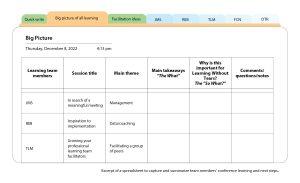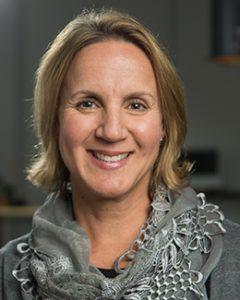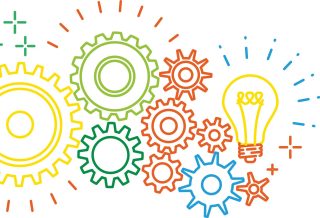FOCUS
Yes, a conference can lead to sustained learning. Here’s how.
By Juliet Correll
Categories: Data, Evaluation & impact, Learning designsAugust 2023
I knew that the Learning Forward Annual Conference could be the cornerstone of my team’s yearlong professional learning strategy and could push us to improve the quality of learning we lead for our educators. I wasn’t sure how 12 busy people who work across nine U.S. states would sustain and deepen our learning over time, but I had some ideas, and the team was more than ready to dig in.
The professional learning team at Learning Without Tears leads the design, development, facilitation, impact assessment, and progressive improvement of professional learning for thousands of educators, therapists, and other practitioners who use Learning Without Tears integrated solutions to build children’s foundational early literacy skills.
We are working to transform the professional learning we facilitate from a long-standing (and highly rated), event-based workshop model to a sustained, just-in-time, learner-centered, and reflective approach. Our team has committed to forming a plan for ongoing professional learning for ourselves as the first step, and the conference provided a perfect opportunity to deepen and shape that commitment, support it, and sustain it.
As the December 2022 conference wrapped up, the potential impact on our work was immediately clear. Yet, a touch of nervous anticipation fluttered across my mind. Would we really make the time to sustain the momentum, to use our learning to enhance our designs and strengthen the impact?
As the professional learning team, within a learning organization that loves collaborating with fellow educators, we were grappling with contrasting assumptions. We knew that we had participated in an unparalleled, yet still one-time event. We also knew the resounding evidence that job-embedded collaborative learning, led by agency and collective efficacy, has the greatest potential to positively affect all students.
When our team had made travel plans for the conference, I had asked everyone to commit to a final hour together for reflections after the last session. During that time, we captured our initial reflections on sticky notes and affinity-mapped them, and we jotted down our collective learning on our organizers, journals, and devices. We put our hands in a circle with the sticky notes in the middle and took a photo so we could remind ourselves of our ongoing commitment to learning.
On the plane ride home, I thought about how we would enact our plan to leverage conference learning and see sustained results over time, using the steps we had established for before, during, and after the conference.
BEFORE THE CONFERENCE – Prime the learning and plan for challenges.
Before the conference, we began shifting our internal and external culture away from workshops to ongoing professional learning. I knew we needed external support, resources, and professional learning to help guide our way. We dove into this pursuit and devoured many forms of professional learning, including the Learning Forward coaching webinar series, practice-focused articles, video exemplars of engaged learning designs, and Standards for Professional Learning, especially the Learning Designs and Culture of Collaborative Inquiry standards. We also integrated professional learning conversations into our regular meetings.
During this process, we started using mantras, like: “Remember to make time for learners to chew the apple” and “An event is not professional learning.” We defined our theory of change for our improved approach to professional learning and articulated a Learning Without Tears professional learning methodology, which we would use as the basis for our evolution.
During the summer, I communicated with the team about the December conference and, especially, about the paradox of participating in a single event to drive sustained change. We talked about the difficulties we would likely encounter to carve out time after the conference and the importance of organizing ourselves beforehand to be ready to apply the learning later. By calling this out early on, I hoped to generate common understanding and commitment to the problem so that we could be strategic about a schedule and structure for moving forward.
As a teacher, I knew that continuing to build background before the conference would provide deeper and broader context for new learning to attach and resonate. I shared content resources here and there, including purchasing a curated book for each team member based on their interests and roles, and we talked about starting book circles in the fall, coming out of our busy pre-back-to-school season.
In parallel, team members selected our concurrent conference sessions, mapping them on a spreadsheet to see who was planning to learn about what and when to ensure coverage across the key topics and themes that were most important to us. We considered where we would split up and determined when we would participate in pairs.
Next, we used the reflection and action planning graphic organizers Learning Forward provides to all conference participants and tailored those for each team member’s conference schedule. Those pages filled the core of slim physical binders we created for each person. I had a moment of concern about the trees lost and the convenience of electronic note-taking, but I also recognized that the act of handwriting notes supports synthesis and fires up more synapses and brain connections than typing ever could.
Make time to chew the apple. For learning to stick, carve out time to hold conversations, process, synthesize, and examine learning. #educators #edutwitter #bestpractice Share on XDURING THE CONFERENCE – Adapt on the fly and build time to reconnect.
When we got to the conference, we were prepared and primed for learning, but we also brought an agile mindset and expected to adapt some of our learning strategies as needed.
As we started moving through our sessions, we quickly realized that we needed to customize the binders we had brought. While the templates were a useful starting place, our learning needs overall and for each session were a little different.
For example, I wanted space before all of that processing to make notes, create simple visuals, draw arrows, and separate the content that I was learning from my process and facilitation notes. I needed this in the Design for Belonging session, in particular, where there were so many useful and engaging learning designs and tools modeled, while I was also trying to capture the gist of how to employ a liberatory mindset as another essential lens when we develop professional learning.
This wasn’t a huge challenge as we easily crossed out, added on, and used our stickies with abandon. But next time, we’ll review and modify the organizers in advance, based on our individual and team lenses and desired learning outcomes.
After every conference day, we reconnected informally as a group after rippling out to our concurrent sessions and joining in plenary sessions. We shared some high-level learning and noticed themes across sessions and team members, which cemented our understanding of the larger context and research basis for our work, and illuminated specific, practical examples for how to enact new ideas. The major focus areas for change that emerged were:
- Recognizing that real change happens from the inside out and empowering learner ownership and agency;
- Compiling strategies to support implementation coaching; and
- Designing professional learning with an equity mindset.
POST-CONFERENCE – Identify key learning and integrate it into daily work.
When we opened our laptops after the conference, we found it was tough for many of us to make time to refocus on what we learned. We were grateful to have done some work filtering through pages of notes, handouts, and online resources. And we gave ourselves grace to modify our plans as needed.
We had designed a simple, blended, two-part post-conference follow-up plan. We scheduled a few live virtual touchpoints for January and February and created a shared digital space to asynchronously organize what we learned and upload supporting artifacts from conference sessions. We ended up shifting the live virtual meetings further out and broke them into smaller-sized ones to provide more flexibility for participation. We also gave ourselves nudges and reminders to populate the shared digital space.
During the live virtual meetings, we identified what we learned that had the greatest impact and related changes or upgrades to make to our work. We then began integrating those into our Learning Without Tears professional learning road map to prepare to implement the upgrades across all of the professional learning we facilitate. This is an ongoing process.
We also continue to embed 10-minute professional learning conversations on relevant topics at the start of every team meeting, with rotating facilitators and occasional outside guests leading the dialogue. Sometimes, these quick chats are centered on something a team member gleaned from an external source or from recent personal insight; others might focus on practical tips for facilitating virtual professional learning. We consider how to infuse new strategies or concepts into our thinking and practice in a frequent and feasible way.
The process of organizing our ideas and ourselves to apply what we learned took a few weeks longer than we’d hoped. We’ve now learned about setting more realistic expectations for our own follow-up.
Impact on our work
We ultimately documented much of what we learned. Specifically, we’ve synthesized many ideas gleaned about effective coaching to create a cohort implementation coaching model that we’re piloting this fall. We will continue to facilitate initial live content sessions that help educators get started, followed by deeper dives into classroom use cases a few weeks later.

Beyond those highly engaging hands-on sessions, we’ll reconnect with those same cohorts throughout the year during their professional learning communities or common planning time for short touchpoints to check in on how implementation is going.
Together, we will review data points, reflect on outcomes, identify what’s working and not, and infuse a bit more pedagogical content knowledge when it’s surfaced by the teachers as needed to guide toward student impact in a more job-embedded way.
We’re also aligning the changes we’ve made to activate learners’ existing knowledge base to foster focused engagement and ownership with the success indicators that are important to us, including learner engagement, knowledge and competency building, mindset shifts, degree of application, and student impact. We’re honing our approach and dashboards to monitor those measures to assess the effectiveness of what we’ve applied and continue learning.
We’re noting promising initial impact from the changes we’ve made. Through a survey from a sample of 114 educators we work with, we’ve seen encouraging and valuable rates of change from professional learning participants who have indicated strong agreement or satisfaction across several indicators, including:
- 12% growth in meaningful opportunities to collaborate;
- 12% growth in the right amount of time to reflect; and
- 9% growth in developing content knowledge.
While we love seeing these numbers go up, our raison d’être is to enhance student learning. So we’ve also started to assess the degree to which these changes in professional learning experiences propel teachers to effectively advance teaching and learning. To move beyond knowledge-level impact, we designed and piloted an application survey to understand what’s happening as teachers apply new learning in practice and identify how we can support them along the way. We’re refining that instrument for the fall, and we’re also outlining an impact-level measure to be deployed later this school year, when we expect to see resultant changes in student outcomes.
Our professional learning facilitators have anecdotal feedback, too, noting comments from participants that their voices are being heard and they feel more confident about their readiness to implement and change their instruction. And our operations team is sharing the data with our customers to bolster feedback loops, including substantiating results and shaping additional learning needs — together. Internally, we’re sharing with our product teams, too, so that student successes and challenges inform not only professional learning improvements, but also ongoing Learning Without Tears program enhancements.
Refueling and reupping our commitment
To strengthen and sustain a learning culture, we’re keeping our top three focus areas from the conference front and center, while folding in additional content. We reviewed the range of 2023 learning opportunities offered by Learning Forward and other organizations, then correlated those topics with the real jobs to be done across the team and areas where we needed more support or deeper understanding. We’ve integrated several of those learning experiences into our schedules.
While we devote nearly all of our workdays to the pursuit of purposeful and impactful professional learning for others, making time for our own learning is not easy. And it’s not only prioritizing time and budget for a conference. It’s about prioritizing goals and needs and then revisiting them with an eye on changing context and equity. It’s knowing what cups to fill, what to fill them with, when to add a little something sweet, and then swirling in the right balance of creative tension to froth. It’s about having regular, collegial conversations where the real learning happens.
We are doing this work imperfectly, but we are doing the work. We are learning what we can do better in the future, and we are reminded that great things don’t happen quickly, even with foresight, shared aspirations, preparation, and loads of momentum.
For example, the book study that we had planned for preconference background building didn’t happen. We had other pressing priorities, and the heft of a full book felt a little overwhelming to open. The purpose remains, but next time we might select a single book for all, instead of tailoring the books to individuals. Further, we might take a jigsaw approach to reading and presenting the chapters so that busy team members aren’t expected to read the whole book, or we might provide other bite-sized content that feels relevant and accessible.
We are learning and refining as we go, trying new things to sustain us on our own way. And we’re preparing for the next Learning Forward Annual Conference in December 2023. We’re ready to put what we’ve learned about conference application into practice and ready to continue the learning cycle to continuously move us forward.
In nine actionable steps, the Learning Without Tears team created a successful structure to support professional learning before, during, and after an education conference. #educators #ProfDev #TheLearning Pro Share on XHow to make conference learning last
Learning Without Tears team’s steps for finding time and creating structure to apply and sustain learning from the Annual Conference:
- Generate common understanding, desire, and shared goals.
- Provide context and build background.
- Plan and register for conference sessions with intention.
- Personalize graphic organizers.
- Implement initial in-person reflection.
- Schedule blended follow-up to codify learnings and plan application.
- Incorporate learning opportunities into regular routines.
- Fold in external resources and support.
- Reflect, assess, modify, and evolve, as needed.

Juliet Correll (juliet.correll@lwtears.com) is vice president for professional learning at Learning Without Tears. She is a past director of the Learning Forward Foundation, past president of a Learning Forward regional affiliate, and a graduate of the Learning Forward Academy.
Categories: Data, Evaluation & impact, Learning designs
Recent Issues
WHERE TECHNOLOGY CAN TAKE US
April 2024
Technology is both a topic and a tool for professional learning. This...
EVALUATING PROFESSIONAL LEARNING
February 2024
How do you know your professional learning is working? This issue digs...
TAKING THE NEXT STEP
December 2023
Professional learning can open up new roles and challenges and help...
REACHING ALL LEARNERS
October 2023
Both special education and general education teachers need support to help...










